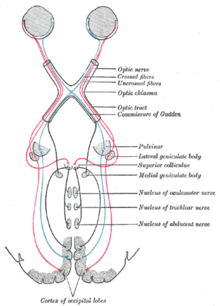
Back متلازمة بارينو Arabic Претектален синдром Bulgarian Parinaud-Syndrom German Síndrome de Parinaud Spanish Syndrome de Parinaud French Sindrome di Parinaud Italian Zespół Parinauda Polish Síndrome de Parinaud Portuguese Синдром Парино Russian กลุ่มอาการปารีโน Thai
This article needs additional citations for verification. (February 2015) |
| Parinaud's syndrome | |
|---|---|
| Other names | Dorsal midbrain syndrome, vertical gaze palsy, upward gaze palzy, sunset sign,[1] setting-sun sign,[2] sun-setting sign,[3] sunsetting sign,[4] sunset eye sign,[5] setting-sun phenomenon[5] |
 | |
| Specialty | Neurology |
Parinaud's syndrome is a constellation of neurological signs indicating injury to the dorsal midbrain. More specifically, compression of the vertical gaze center at the rostral interstitial nucleus of medial longitudinal fasciculus (riMLF).
It is a group of abnormalities of eye movement and pupil dysfunction and is named for Henri Parinaud[6][7] (1844–1905), considered to be the father of French ophthalmology.
- ^ Larner, A. J. (2001). A Dictionary of Neurological Signs: Clinical Neurosemiology. Springer Science & Business Media. p. 202. ISBN 978-1-4020-0042-3.
- ^ Biglan, Albert W. (January 1984). "Setting Sun Sign in Infants". American Orthoptic Journal. 34 (1): 114–116. doi:10.1080/0065955X.1984.11981637.
- ^ MPH, Eudocia Quant Lee, MD; MD, David Schiff; MD, Patrick Y. Wen (2011-09-28). Neurologic Complications of Cancer Therapy. Demos Medical Publishing. p. 383. ISBN 978-1-61705-019-0.
{{cite book}}: CS1 maint: multiple names: authors list (link) - ^ Waterston, Tony; Helms, Peter; Ward-Platt, Martin (2016-07-06). Paediatrics: A Core Text on Child Health, Second Edition. CRC Press. p. 149. ISBN 978-1-138-03131-9.
- ^ a b Gaillard, Frank. "Sunset eye sign | Radiology Reference Article | Radiopaedia.org". Radiopaedia. Retrieved 2020-01-05.
- ^ synd/1906 at Who Named It?
- ^ H. Parinaud. Paralysie des mouvements associés des yeux. Archives de neurologie, Paris, 1883, 5: 145-172.
© MMXXIII Rich X Search. We shall prevail. All rights reserved. Rich X Search